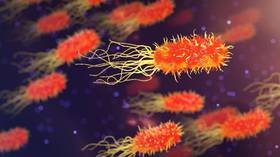Research identifies possible new secret weapon in fight against antibiotic-resistant bacteria

New research into a specific mechanism by which bacteria develop resistance to antibiotics has yielded a potential game changer for next-generation drugs to win the arms race against antimicrobial resistance (AMR) in bacteria.
The study, led by professor Tony Maxwell, investigated quinolone antibiotics, which are used to fight numerous bacterial infections up to and including TB (tuberculosis).
Quinolones work by inhibiting certain enzymes in bacteria which prevent them from replicating their DNA and synthesising RNA, stopping them dead in their tracks, hence their widespread use in modern medicine.
Also on rt.com Extreme gonorrhoea & superbugs to be vanquished by ‘POISON ARROW’ drug, researchers claimBut therein lies the problem, as bacterial resistance to this and other leading treatments grows worldwide, there is a gap in the medicinal arsenal for treating many particularly nasty infections.
One resistance mechanism, called pentapeptide repeat proteins (PRPs), can confer quinolone resistance to Mycobacterium tuberculosis, the bacterial mastermind behind TB.
John Innes Centre researchers, led by Maxwell, conducted a deep-dive investigation into these PRPs at a molecular level, to gain a better understanding of what they were up against and how they might be able to neutralise it.
Also on rt.com CDC raises alarm over surge of drug-resistant superbugs infecting 3 million Americans annually & killing 4 people every hourThey took a purified form of a similar bacterium, mycobacterium smegmatis, and found that a PRP called MfpA can disrupt a DNA process which is essential for quinolone to effectively target the right enzyme in the bacteria, thus shielding the bacteria from the antibiotic airstrike, so to speak.
“We believe this understanding will help drive new ideas for antibiotic development among academics and researchers in the pharma industry,” Maxwell said.
Further research will develop molecular models based on MfpA's structure to create small molecules with similar functionality, with a view to preventing collusion between MfpA and the bacteria and allow next-generation antibiotics to destroy their targets.
Think your friends would be interested? Share this story!













